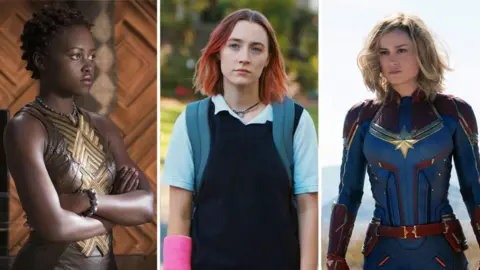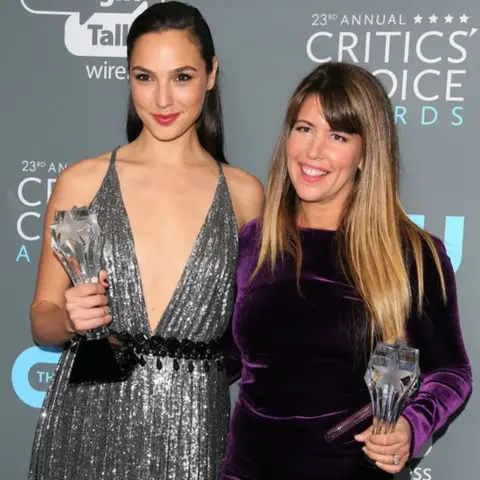Is a female lead now key to box office success?
 Alamy
AlamyUS awards season is in full swing - and so is the debate around representation (and a gaping lack thereof) in Hollywood. But the landscape for women in media may be changing for the better.
Last year, female-centric films Lady Bird, Shape of Water, and Three Billboards Outside of Ebbing, Missouri, earned accolades and awards.
And 2019's list of likely Oscar darlings includes a number of female contenders, including Lady Gaga for best actress for her role in A Star is Born, Viola Davis in Widows, and the trio of Olivia Colman, Rachel Weisz and Emma Stone for best lead and supporting roles in The Favourite.
Anecdotally, it seems that films featuring women - in front of the camera or behind the scenes - gain serious critical acclaim.
Here's what the experts have to say about the change we've started to see at the awards shows.
Women-led films outperform
Some advocates are hoping proof of profitability will show industry executives that female representation matters.
According to a study published last Tuesday by entertainment group Creative Artists Agency and tech company shift7, women-led films saw bigger success at the box office.
The two companies conducted the study as a part of the Time's Up movement that called for a change in gender relationships in the film industry.
Analysing box office data for films from 2014 to 2017, researchers found that the top grossing blockbusters all starred women in leading roles.
 JEAN-BAPTISTE LACROIX/AFP/Getty Images
JEAN-BAPTISTE LACROIX/AFP/Getty ImagesOn average, across budgets ranging from under $10m (£8m) to $100m, films with women as the lead actors - the coveted first listing in billing - performed better at box offices worldwide.
A BBC analysis earlier this year also found that female-led Oscar films were more profitable than their male-led counterparts.
Amy Pascal, the former Sony Pictures chair who led the joint research team, said in a statement: "This is powerful proof that audiences want to see everyone represented on screen."
The report also looked at how films stood up to the Bechdel test - which asks whether a film has at least two named female characters who have a conversation about something unrelated to a man.
Films that passed this test did better than those that failed - and since 2012, no film has grossed $1bn without passing, though 40% of flicks still fail.
"It's not news to anyone who studies this industry that women-led movies do well at the box office," says Melissa Silverstein, film industry expert and founder of the Women and Hollywood advocacy group.
Ms Silverstein explained that advocates have made a big deal about women-centric films making money because of the historic lack of such films.
For example, in 2011, women accounted for 11% of protagonists in the 100 top grossing films, according to a study from San Diego State University, and as of last year, that number has risen to just 24%.
That was thanks to a the false assumption that only teenage boys drove box office sales, she told the BBC, and that women's movies were not profitable. Over the last several decades, those beliefs translated to a serious lack of women on the big screen.
Allow Instagram content?

But hiring women, Ms Silverstein says, is "not just the right thing to do - it's the right thing to do for your business model."
Though the playing field is still far from even, to Ms Silverstein, the future looks bright.
Last year's top three films, Star Wars, Wonder Woman and Beauty and the Beast all featured women in starring roles.
"I look at this year and I see Black Panther as the number one grossing film across the world, [with] amazing women characters and an embrace of the need for inclusion."
 Alamy
Alamy "There are several big budget movies with female protagonists and female directors coming next year," she adds. "We're going to see the change we've been pushing for."
What's behind the momentum?
Change has been a long time coming.
Ms Silverstein says it is not entirely correct to pin the increase in women on screen to movements like #MeToo and Time's Up, as most of the female-led endeavors garnering praise now began production years prior.
But these new waves have helped spark wider-reaching discussions.
Pat Gill, professor emerita of gender, film and media studies at the University of Illinois at Urbana-Champaign, told the BBC that social media has played a big part in helping decades of fighting see more mainstream action.
"That is what I think is unique about this era's feminist/equality movement: the employment of social media venues to obtain support and galvanize action," she says.
"#MeToo and Time's Up are examples of the astonishing power of the media to increase awareness, gain advocates, and initiate change."
 Getty Images
Getty ImagesBut how much has really changed?
Prof Martha Lauzen, director of the Center for the Study of Women in Television and Film at San Diego State University, told the BBC the data still does not show much improvement for women in Hollywood over the last two decades, despite the hubbub of recent movements.
"The disconnect between perception and reality has been exaggerated by media reports suggesting the industry is undergoing 'seismic' or 'tectonic' change," Prof Lauzen says.
Media attention has yet to translate into more female hires, and men still hold most positions of power in the industry.
Behind-the-scenes roles, like directors, writers, producers and editors, have also seen no substantial increases in female representation, Prof Lauzen noted.
And despite praise for female-led films, only one woman - Kathryn Bigelow - has ever won the Oscar for best director.
A July report from USC Annenberg found that out of 1,100 popular films from 2007 to 2017, only 13% had gender balanced casts; out of over 48,000 speaking roles, women held 34%.
Prof Lauzen says it is unlikely any real change will happen without an "industry-wide mandate" to do so.
Ms Silverstein of Women and Hollywood echoed a similar thought.
"Mandates, quotas - nobody likes those words," she says. "But the whole thing is just: hire women."
"They need to stop saying they can't find women because that's not true."
 Pictorial Press Ltd / Alamy Stock Photo
Pictorial Press Ltd / Alamy Stock PhotoThe complications of inequality
Female-centric films may now have some hard proof of their critical and box office prowess, but Hollywood's inequalities run along more than just gender lines.
In order to truly lock down this upward trend, Prof Gill emphasised that the industry and advocates need to understand racial issues too.
"While equalizing changes in gender status and their continuing trajectory are heartening, they are also uneven. Women of colour find it harder to have their skills acknowledged and rewarded."
Race must be "recognized as distinct" and not seen as "addressed under the umbrella concerns of the movements," she says.
And this year, some critics have already pointed out that actresses of colour like Constance Wu and Regina King are still losing out at awards shows to their white peers, like Emma Stone and Amy Adams.
But across the media world, there was a sign of hope: the fashion industry reported a year of record-breaking covers, with nearly half featuring people of colour.
Allow X content?

Last Monday, fashion industry site Fashionista released its annual look into magazine cover diversity and found 48.4% featured people of colour. InStyle topped the rankings with 75% of issues featuring non-white people on the cover.
The report concluded: "Diversity and inclusion do appear to be a priority when it comes to selecting cover stars."
"Film and print media reflect, comment on and take cues from each other," says Prof Gill, who says this change will only continue.
"There's no going back," she adds. "It would be very hard to silence this newly-galvanised, powerful feminist media voice."
